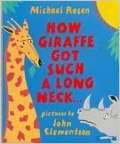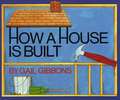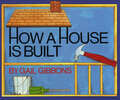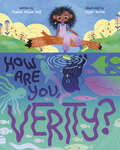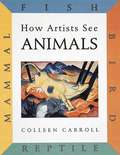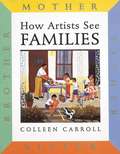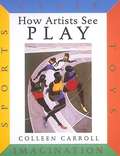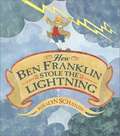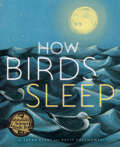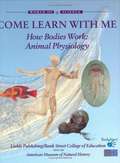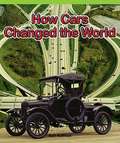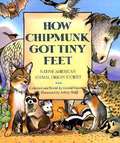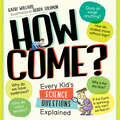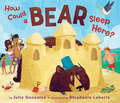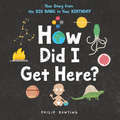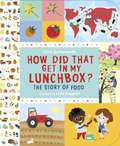- Table View
- List View
How a City Works (Let's-Read-and-Find-Out Science 2)
by D. J. WardRead and find out about how cities work in this colorfully illustrated nonfiction picture book.Millions of people live in cities around the world, but have you ever wondered how cities work? All those people need clean water to drink, a safe place to live, and a way to get all around the city. How do you take care of all those people’s needs? Read and find out all about the systems a city has to help keep everyone safe, healthy, and happy.This book on city systems will appeal to the young civil engineer. How a City Works is filled with fun, accurate art, and includes tons of information. For example, it answers the question: Where does all the electricity needed to make a city run come from? How a City Works covers water treatment, power, sewage, recycling, and transportation.How a City Works comes packed with visual aids like charts, sidebars, an infographic, and a funny, hands-on activity—how to clean up dirty “sewage” water, using puffed rice cereal, raisins, hot chocolate mix, and coffee filters.This is a clear and appealing science book for early elementary age kids, both at home and in the classroom. It's a Level 2 Let's-Read-and-Find-Out, which means the book explores more challenging concepts for children in the primary grades. The 100+ titles in this leading nonfiction series are:hands-on and visualacclaimed and trustedgreat for classroomsTop 10 reasons to love LRFOs:Entertain and educate at the same timeHave appealing, child-centered topicsDevelopmentally appropriate for emerging readersFocused; answering questions instead of using survey approachEmploy engaging picture book quality illustrationsUse simple charts and graphics to improve visual literacy skillsFeature hands-on activities to engage young scientistsMeet national science education standardsWritten/illustrated by award-winning authors/illustrators & vetted by an expert in the fieldOver 130 titles in print, meeting a wide range of kids' scientific interestsBooks in this series support the Common Core Learning Standards, Next Generation Science Standards, and the Science, Technology, Engineering, and Math (STEM) standards. Let's-Read-and-Find-Out is the winner of the American Association for the Advancement of Science/Subaru Science Books & Films Prize for Outstanding Science Series.
How a Giraffe got such a long neck: A Tale From East Africa
by Michael RosenVersions of this story are told in many parts of East Africa. Similar tales are told by the Kikuyu and Masai tribes in Kenya and by tribes in Southern Africa. This version has been adapted by permission of Nick Greaves from an East African folktale that appears in When Hippo Was Hairy (DavidBateman Ltd. New Zealand, 1988). The artist has based his depiction of Man on early Masai tribesmen.
How a House is Built
by Gail GibbonsGail Gibbons uses clear, simple wording to present all the steps involved in building a house. From the architect who draws the plans, through the various types of workers who construct it, to the family who will make the house their home, each aspect is explained. Children can easily follow along as construction begins at the ground level with surveyors, describing the jobs of carpenters and plumbers. The many tools used to complete each task are explained, ultimately showing how all the workers' efforts come together to build a whole house from basement to roof, both inside and outside.
How a House Is Built
by Gail GibbonsHouses are built with many different materials, and in many shapes and sizes. Step by step, this picture book explains how homes are built—from the architect's plans through the arrival of a happy family. The many processes of construction are explained with simple language and bright, clear illustrations, perfect for kids starting to wonder about how the world around them works. Many different careers—including carpenters, plumbers, electricians, and landscapers—are introduced, each doing their part to bring the picture wood-frame house to life. A great read for kids who love construction sites, or who can't get enough of Building a House by Byron Barton. According to The Washington Post, Gail Gibbons "has taught more preschoolers and early readers about the world than any other children's writer-illustrator." Ms. Gibbons is the author of more than 100 books for young readers, including the bestselling titles From Seed to Plant and Monarch Butterfly. Her many honors include the Washington Post/Childrens Book Fuild Nonfiction Award and the NSTA Outstanding Science Trade Book Award.
How a Seed Grows (Let's-Read-and-Find-Out Science 1)
by Helene J. JordanRead and find out about how a tiny acorn grows into an enormous oak tree in this colorfully illustrated nonfiction picture book.This is a clear and appealing environmental science book for early elementary age kids, both at home and in the classroom. Plus it includes a find out more activity section with a simple experiment encouraging kids to discover what a seed needs to grow.This is a Level 1 Let's-Read-and-Find-Out, which means the book explores introductory concepts perfect for children in the primary grades. The 100+ titles in this leading nonfiction series are:hands-on and visualacclaimed and trustedgreat for classroomsTop 10 reasons to love LRFOs:Entertain and educate at the same timeHave appealing, child-centered topicsDevelopmentally appropriate for emerging readersFocused; answering questions instead of using survey approachEmploy engaging picture book quality illustrationsUse simple charts and graphics to improve visual literacy skillsFeature hands-on activities to engage young scientistsMeet national science education standardsWritten/illustrated by award-winning authors/illustrators & vetted by an expert in the fieldOver 130 titles in print, meeting a wide range of kids' scientific interestsBook in this series support the Common Core Learning Standards, Next Generation Science Standards, and the Science, Technology, Engineering, and Math (STEM) standards. Let's-Read-and-Find-Out is the winner of the American Association for the Advancement of Science/Subaru Science Books & Films Prize for Outstanding Science Series.
How Animal Babies Stay Safe (Let's-Read-and-Find-Out Science 1)
by Mary Ann FraserRead and find out about how animal parents keep their babies safe from predators in this colorfully illustrated nonfiction picture book.This is a clear and appealing science book for early elementary age kids, both at home and in the classroom. It looks at the many strategies animal babies use to survive in a dangerous world. Some babies hide in nests or dens, some ride on thier parents' back or in their pouches, some use camouflage, and some rely on their parents' sharp claws and teeth to fend off enemies. Whether showing "a mother monkey swinging through the jungle with her baby on her back or two baby raccoons peeking out of their tree-house home while their mother lures a bobcat away from her young," wrote Kirkus, this book captures the eternal appeal of baby animals.It's a Level 1 Let's-Read-and-Find-Out, which means the book explores introductory concepts perfect for children in the primary grades. The 100+ titles in this leading nonfiction series are:hands-on and visualacclaimed and trustedgreat for classroomsTop 10 reasons to love LRFOs:Entertain and educate at the same timeHave appealing, child-centered topicsDevelopmentally appropriate for emerging readersFocused; answering questions instead of using survey approachEmploy engaging picture book quality illustrationsUse simple charts and graphics to improve visual literacy skillsFeature hands-on activities to engage young scientistsMeet national science education standardsWritten/illustrated by award-winning authors/illustrators & vetted by an expert in the fieldOver 130 titles in print, meeting a wide range of kids' scientific interestsBooks in this series support the Common Core Learning Standards, Next Generation Science Standards, and the Science, Technology, Engineering, and Math (STEM) standards. Let's-Read-and-Find-Out is the winner of the American Association for the Advancement of Science/Subaru Science Books & Films Prize for Outstanding Science Series.
How Animals Protect Themselves (Rigby Leveled Library, Level Q #62)
by Pamela RushbyNIMAC-sourced textbook
How Are You, Verity?
by Meghan Wilson DuffA neurodivergent child interacts with their neighbors to discover the true meaning behind greetings and salutations. When people say &“How are you?&” are they really asking or just saying hello? Verity, who is neurodivergent, plans an experiment to figure this out. Verity is bubbling with excitement about an upcoming school field trip to the aquarium! When neighbors ask, &“How are you?&” Verity shares their excitement and fascinating facts about sea animals. Their older brother John kindly suggests that the question "How are you?" is actually a greeting and not an invitation to share so much. Verity plans an experiment to find out if their brother is right. But when the trip to the aquarium is cancelled, Verity is heartbroken. When people ask &“How are you?&” what should they say then?
How Artists See Animals: Mammal, Fish, Bird, Reptile
by Colleen CarrollExamines how different kinds of animals have been depicted in works of art from different time periods and places.
How Artists See FAMILIES: Mother, Father, Sister, Brother
by Colleen CarrollExamines how families have been depicted in works of art from different time periods and places.
How Artists See Play: Sports Games Toys Imagination
by Colleen CarrollExamines how sports, games, toys, and other aspects of play have been depicted in works of art from different time periods and places.
How Ben Franklin Stole the Lightning
by Rosalyn SchanzerBen Franklin was the most famous American in the entire world during colonial times. No wonder! After all, the man could do just about anything. Why, he was an author and an athlete and a patriot and a scientist and an inventor to boot. He even found a way to steal the lightning right out of the sky.<P><P> Is such a thing possible? Is it. Take a look inside and find Ben busy at work on every spread. Then find out how he used his discovery about lightning to make people's lives safer.<P> In an inventive way, Rosalyn Schanzer brings us a brilliant and ever-curious American original.
How Birds Sleep
by David ObuchowskiDiscover the mysterious and fascinating sleeping habits of more than twenty bird species from around the world in this gorgeously illustrated read-aloud picture book, perfect for bedtime, or any time.Have you ever seen a bird sleep? Or wondered just when it is that migrating cranes find the time to catch Z&’s as they cross the ocean? From the parrots of Thailand to the ostriches of Australia and even the pigeons of New York City, every bird sleeps—but they do it in ways that will surprise and delight you. Some hang from tree branches, others doze while gliding, and some even burrow underground for a nap. Written in a witty, conversational voice, and with gorgeous illustrations, this picture book is bursting with interesting facts about this underexplored aspect of bird life all around us.
How Bodies Work: Animal Physiology
by Bridget AndersonDo you ever wonder what makes you grow? Or why you shiver when you are cold? Have you ever marveled at the speed of a cheetah, the fastest land animal on Earth? Or been awed at how a chameleon can change color? Solving such mysteries is part and parcel of animal physiology, the science that investigates how different animal bodies work. Learning how they do increases our appreciation of the uniqueness and diversity of the vast animal kingdom, and adds to our understanding of how our own bodies work. HOW BODIES WORK: ANIMAL PHYSIOLOGY offers a glimpse inside ourselves and the amazing world around us.
How Can We Predict Patterns of Motion?: Student Activity Guide
by The Smithsonian InstitutionNIMAC-sourced textbook
How Can We Protect Animals When Their Habitat Changes? Student Activity Guide
NIMAC-sourced textbook
How Cars Changed The World
by Kurt HoffmanBright, full-color and black and white historic photographs compare and contrast the cars, roads, and travel experiences of today with those of days gone by. Strongly correlated to the Common Core Standards for Informational Text, this title is perfect for exploring the relationships between a series of historical events and scientific ideas.
How Caterpillars Turn Into Butterflies (Nature's Mysteries Ser.nature's Mysteries)
by Jill BaileyYoung readers can learn about many of the most amazing aspects of nature in this strikingly illustrated set of books. Ideal for the reader who must know how nature works, this series has the answers to many questions, helping to open up the world of nature's secrets.
How Chipmunk Got Tiny Feet (Native American Animal Origin Stories)
by Gerald HausmanHow Coyote got yellow eyes, How Bat learned to fly, How Lizard got flat, How Hawk stopped the flood with his tail feather, How Horse got fast, How Possum lost his tail, and How Chipmunk got tiny feet.
How Come?: Every Kid's Science Questions Explained
by Kathy WollardFact-filled, fun-filled, as interesting to parents as it is to kids, the How Come? series is the trusted source for lively, clear answers to kids’ science queries. Now the best questions and answers from all three books—How Come?; How Come? Planet Earth; and How Come? In the Neighborhood—have been revised, updated, freshly illustrated in full color, supplemented with twenty completely new questions, and combined into one bigger, better volume. How Come? explains, in fascinating detail, more than 200 mysteries and phenomena in the world around us. These are the questions that pique kids’ curiosity—and stump parents.When it rains, does running (rather than walking) to the nearest shelter really keep you any drier? How can a stone skip across a pond (instead of sink)? If the Earth is spinning, why can’t we feel it? Why don’t we fly off? Why do elephants have trunks? And the all-time classic, Why is the sky blue? (Sunlight has a hidden rainbow of colors, and air molecules scatter blues the most—sending bright blue light down to Earth.) The text is clearly written, engaging, and accessible. It’s for every kid who wants to know—and every grown-up who simply doesn’t know.
How Could a Bear Sleep Here?
by Julie GonzalezIt's time for Shelby to hibernate, but how could a bear sleep in this noisy forest?The woodpeckers are rat-tat-tatting, the squirrels are cracka-cracka-crunching--there's too much noise! When Shelby spies the perfect cave, only too late does he realize he's hopped aboard a tour bus bound for the beach.Coupled with hysterically expressive illustrations by Stephanie Laberis, Julie Gonzalez's lively text and familiar refrain sings as Shelby, after several attempts to snooze in the tropics with increasing exhaustion, finally discovers the perfect solution to his noise problem. This is a great read-aloud for young readers who will recognize the refrain ("How could a bear sleep here?") and the silliness of Shelby's predicament
How Deep Is the Ocean? (Let's-Read-and-Find-Out Science 2)
by Kathleen Weidner ZoehfeldRead and find out about the deepest part of the ocean in this colorfully illustrated nonfiction picture book.The ocean covers almost three-quarters of the Earth, but how deep does it go? Put on your scuba gear and explore the ocean, from its shallowest waters to its deepest, most mysterious parts. As you dive deeper, you’ll discover glowing animals, strange creatures that don’t need sunlight to survive, and even the largest hunter in the world.With beautiful illustrations and engaging text, How Deep Is the Ocean? will guide young readers into the deepest parts of the ocean. Featuring a find-out-more section with a water-pressure experiment, a lesson in making a sounding line to learn how scientists measure the depth of the ocean, a glossary of new terms, and web research prompts, this book will begin children’s explorations of the deep sea. Both the text and the artwork were vetted for accuracy by Dr. David Gruber, real-life deep sea explorer and professor of biology and environmental science at Baruch College.This is a clear and appealing science book for early elementary age kids, both at home and in the classroom. It's a Level 2 Let's-Read-and-Find-Out, which means the book explores more challenging concepts for children in the primary grades. The 100+ titles in this leading nonfiction series are:hands-on and visualacclaimed and trustedgreat for classroomsTop 10 reasons to love LRFOs:Entertain and educate at the same timeHave appealing, child-centered topicsDevelopmentally appropriate for emerging readersFocused; answering questions instead of using survey approachEmploy engaging picture book quality illustrationsUse simple charts and graphics to improve visual literacy skillsFeature hands-on activities to engage young scientistsMeet national science education standardsWritten/illustrated by award-winning authors/illustrators & vetted by an expert in the fieldOver 130 titles in print, meeting a wide range of kids' scientific interestsBooks in this series support the Common Core Learning Standards, Next Generation Science Standards, and the Science, Technology, Engineering, and Math (STEM) standards. Let's-Read-and-Find-Out is the winner of the American Association for the Advancement of Science/Subaru Science Books & Films Prize for Outstanding Science Series.
How Did I Get Here?: Your Story from the Big Bang to Your Birthday
by Philip BuntingFrom the Big Bang to your birthday, and (almost) everything in between, this funny and informative book tells your story.You are one of the newest members of a family tree that goes way, way, way back to the very first life on Earth. A lot of incredible things had to happen between the beginning of the universe and today in order to make you. The fact that you (and everyone you know) are here is nothing short of mind-boggling! Read this book to discover how it happened, and prepare to be amazed by the awesomeness of you.This clever, funny, and scientific timeline of the journey of human existence is designed to get young readers asking questions, finding answers, and marveling at the many wonders of our world, from the Big Bang, to evolution, to a brand-new baby, and more.
How Did That Get in My Lunchbox? The Story of Food
by Chris ButterworthFresh retro artwork lures little readers on a tasty trip to farms, dairies, and more. Yum! The best part of a young child's day is often opening a lunchbox and diving in. But how did all that delicious food get there? Who made the bread for the sandwich? What about the cheese inside? Who plucked the fruit? And where did the chocolate in that cookie get its start? From planting wheat to mixing flour into dough, climbing trees to machine-squeezing fruit, picking cocoa pods to stirring a vat of melted bliss, here is a clear, engaging look at the steps involved in producing some common foods. Healthy tips and a peek at basic food groups complete the menu.


